…where east meets west
- Home
- Brief History
- The Greenwich Meridian
- Greenwich
(1675–1958) - Herstmonceux
(1948–1990) - Cambridge
(1990–1998) - Outstations (1822–1971)…
- – Chingford (1822–1924)
- – Deal
(1864–1927) - – Abinger
(1923–1957) - – Bristol & Bradford on Avon
(1939–1948) - – Bath
(1939–1949) - – Hartland
(1955–1967) - – Cape of Good Hope
(1959–1971)
- Administration…
- – Funding
- – Governance
- – Inventories
- – Pay
- – Regulations
- – Royal Warrants
- Contemporary Accounts
- People
- Publications
- Science
- Technology
- Telescopes
- Chronometers
- Clocks & Time
- Board of Longitude
- Libraries & Archives
- Visit
- Search
Stables, workshops, sheds and other miscellaneous buildings
The nineteenth century saw a great proliferation of wooden buildings on the two adjoining parts of the Observatory site known as the Magnetic and South Grounds – the level area lying to the south of the Meridian Building. They had a wide variety of different uses. Two of the more substantial structures had their positions altered at different times to make way for other more permanent buildings.
All the wooden buildings that occupied the Observatory site have now been demolished. Those of the Magnetic and Meteorological Observatory are described elsewhere. Of the rest, some, but not all are described here together with some of the smaller brick built structures.
The Stables, carpenter’s workshops and Foreman of Works Office
Although Flamsteed had a stable, it seems to have been constructed very much as an afterthought. The first mention of it comes in the accounts for June 1678 when 4 shillings was paid ‘for 2 Bunches of Laths, and 100 of Tiles to cover the Stable’ (RGO1/2/185–7). In December 1678, 2 shillings was paid for ‘12 Rigg [Ridge] Tiles for the Gable on the new Stable’. The building appears to have been completed by the following March, when payment was made for a lock to be installed on the door. The stable does not appear in any surviving plan or view of the Observatory, leaving both its location and the date of its subsequent removal, a matter of conjecture.
Between 1749 (when additional land was enclosed for the construction of a new observatory building for Bradley (now part of the Meridian building)) and 1773, (probably earlier rather than later) Flamsteed’s Garden House was converted into stabling for two horses. Click here to read more. These stables remained in use until access was blocked by two extensions of the Meridian Building in 1808/9 and 1813. The old stables were converted into a store room for lumber etc in 1816 (RGO6/1/54).
Airy’s plan of 1846 (ADM140/426), (later published in part in 1847), shows the presence of a single story building of about 7 by 3 meters running close to and parallel to the site boundary just to the south of where the centre of the Great Equatorial Building housing the 28-inch Telescope now stands. It is divided into three sections: a Carpenter’s workshop (occupying about half the building), a Water Closet (W.C.) and a stable for two horses. There is no information as to when the building was erected. It is shown in outline form on a sketch plan made by Airy in 1836 and was probably put up either by him at around that date or soon after 1814 when additional land was enclosed from the park including the site on which they stood was.
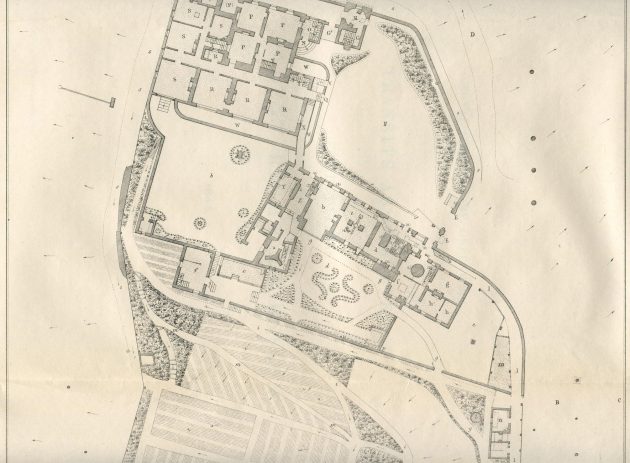
Detail from the 1847 plan published in the 1845 volume of Greenwich Observations. Airy moved the stables from the building marked (f) to the building bottom right marked (m). It consisted of three parts. From south to north (bottom to top) they were the stables (two stalls), a W.C. and the Carpenter's workshop
A new Carpenter’s shop was built in 1855 (close to where Christie later built the Altazimuth Pavilion) and the range demolished in about 1856 to make way for the great equatorial building that today houses the 28-inch refractor. The Observatory then appears to have had no stabling of its own for the next 50 years.
The erection of the South Building, required the Magnetic Offices to be removed as they occupied part of the site. Rather than demolish them, they were rotated out of the way by turning them around by about 90o. No longer of any use for magnetic work after the staff moved into their new offices in the South Building, they found a new use as stables. The Navy Estimates for the year 1898–99 show that Christie asked for £75 to convert four of the seven offices into two loose boxes, a harness room and a coach house in order to provide stabling for visitors as the nearest otherwise available was nearly a mile away (RGO7/51). The earliest reference to them being used as such, seems to be the site plan dating from around 1905. By the 1940s, the seven former Offices were deployed as follows: Offices 1 & 2 (the most southerly) as garages, Office 3 as an empty case store, Office 4 as a paint store and Offices 5 to 7 as stables. They were badly damaged by a blast in the Second World War and demolished some time around 1959/60.
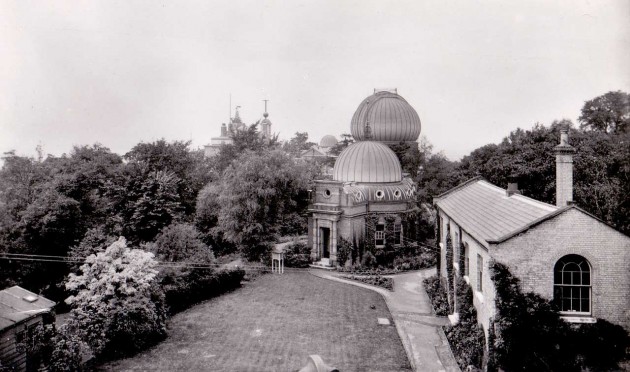
Taken from the South Building in the 1930s, the left side of the photograph shows the north end of the range of old Magnetic Offices in their then role as stables. The Library built by Airy in the 1880s and demolished together with the stables in the late 1950s is on the right. To its left is the Altazimuth Pavilion with the Great Equatorial Building behind. From a postcard published by the Royal Observatory, Greenwich
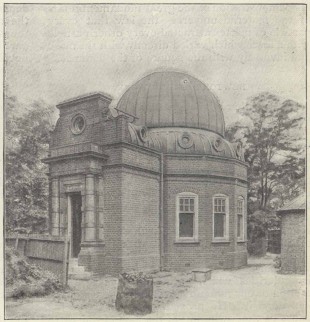
The newly completed Altazimuth Pavilion with the curved corner of the Foreman of Works Office to its right. The Works Office was demolished soon after the photo was taken. From The Leisure Hour (1898)
The Great Shed
In 1851/2, the Astronomer Royal, George Airy, had a large shed erected on the eastern side of the Magnetic Ground to provide an open shelter for storage. Following the extension of the grounds by the enclosure of additional land to the south in 1868, the shed, which by then had become known as the Great Shed (in order to distinguish it from other sheds), was moved to the new southern boundary where it was re-erected in 1869. At the same time, the Depôt for Publications (see below) was erected immediately to its east in the south-east corner of the extended grounds. A plan drawn up by Christie in 1891, gives the external dimensions of the Great Shed as 40 feet 10 inches by 15 feet 7 inches, with a height of 12 feet 0 inches at the ridge and 8 feet 3 inches at the eaves. The shed had a slate roof and was open on the long side facing into the Observatory grounds; the opening being divided into four equal parts by the roof’s supporting pillars.
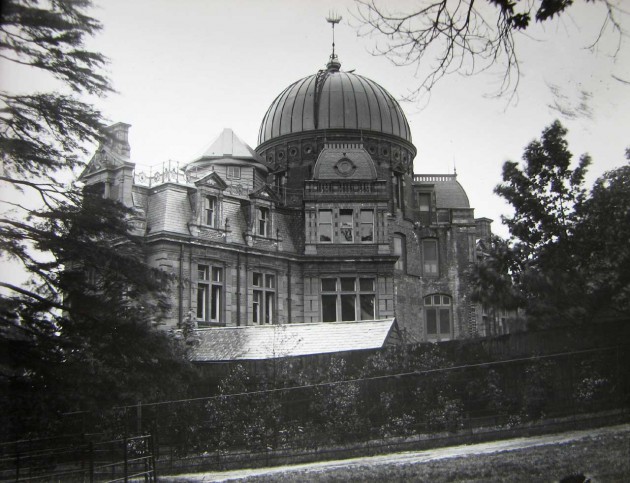
The Great Shed in the summer of 1897 with the south wing and central tower of the partially completed New Physical Building (South Building) behind it. The hut on the roof of the south wing was temporary and housed one of the Observatory's photoheliographs orignally acquired for the 1874 Tranist of Venus expedition (see below). The Depôt for Publications is partially visible behind the trees on the right. The Photograph was taken from Greenwich Park and is reproduced by permission of the Greenwich Heritage Centre (see below). It was also published in the 17 July 1897 edition of the Illustrated London News
One reason given by Christie for erecting the New Physical Building (South Building) in the 1890s was to allow for the rationalisation of storage and with it the removal of the many sheds that existed at the southern end of the Observatory site. Although some buildings had to be demolished or moved to make way for the New Physical Building, the Great Shed survived until the new building’s completion when it was demolished, most probably in 1899. The 1896 site plan implies that between 1891 and 1896, the Great Shed was divided into two equal parts, with the eastern half being closed in, but still accessed from the outside. During the same period, the WCs that had occupied a position on the boundary immediately to the north of the proposed New Physical Building were demolished and a new set erected between the Great Shed and the Depôt for Publications. They appear on the site plans updated to 1896 and around 1905, but not on the later version updated to 1911.
Amongst the items deposited in the Shed at different times, was the scale of equal parts, 16 feet in length, lent by Mr. De La Rue for determination of the distortion of the Photoheliographs of the Transit of Venus that was taken down from the roof of the Octagon Room in 1877.
The Depôt for Publications
By the mid 1860s Airy was running out of space in which to store the numerous spare copies of the published observations. Most were kept in the East Depôt, a north facing ground floor room at the eastern end of the Meridian Building (now incorporated into the Observatory shop). Others were kept in the Upper Depôt, a first-floor-room (now demolished) under the Altazimuth Dome in the Meridian Building, additional space being commandeered in 1866/7 in the south wing of the Magnetic Observatory for the magnetic and meteorological observations. In 1868, Airy therefore decided to construct a new depôt for the printed productions of the Observatory. In his report to the Visitors he stated:
‘I have now selected a place on our own grounds, at the south-eastern corner of the inclosure, where a building can be erected, about 35 feet in length and 13 in breadth, its back ranging with the back of the Great Shed, and its end ranging with the back of the Magnetic Offices, a sufficient passage being left at the east end of the Magnetic Offices. I propose to fit up this repository by the simple arrangement of six racks of book-shelves, with three alleys between them, each alley having a separate door at the south end; the illumination being given by sky lights made of thick glass plates, of the same size as slates, and intermingled with the slates of the roof. The materials removed from the old floors of the South-East Dome [the East Depôt] will supply to a considerable extent the wants of this building.
It is an inconvenience attending this plan that the free draught, of air over our grounds and past our thermometers will be in some measure interrupted. The authorities of the Observatory must look forward to an extension of its grounds; a thing which cannot be effected without difficulty.’
The extension of the grounds followed at the end of the year. In his 1869 report Airy was able to tell the Visitors:
‘The new depôt for the Printed Productions of the Observatory, to the proposed plan of which I alluded in my last Report, was in progress of construction; but, in anticipation of the extension of territory, I had so arranged its frame that it could be transported to a new position with little trouble. The new ground was extremely uneven, but, by a considerable amount of earth-work, and by erection of substantial retaining walls in some parts, I have been able to arrange it in two horizontal planes at different elevations. The depot is transferred to its position in the new ground, and its internal fittings are advancing.’
The new site was in the extreme south-east corner on the spot currently (2015) occupied by the Observatory’s rubbish bins.
Some of the Visitors were sceptical about the plan believing that the books would suffer from dampness in the unheated shed. Airy sought to reassure them stating in his 1870 report that an examination of the books had shown no signs of damage occurring during the previous winter. In the event, Airy was proved wrong, and in 1891, his successor Christie was proposing to rehouse them in the yet to be built South Building. Christie was successful in getting the new building built, the publications were duly rehoused, and the Depôt for publications demolished in about 1899, soon after the South Building was finally completed.
The Observatory soon found itself short of storage space once again. To remedy this, the land to the west of the South Building was enclosed in 1907 to enable the building of the Lower Store (now the toilets in the Park). When in 1909/10, additional accommodation for the storage of the Greenwich and Cape Observatory Publications became necessary; eight double sets of shelves were erected there to accommodate them.
The Transit of Venus huts
In the run up to the British Transit of Venus expeditions of 1874, the various telescopes were assembled in their portable huts for testing and familiarisation prior to being shipped overseas for the Transit. Whilst many were accommodated in the South Ground, others were set up to the north in the Magnetic Ground and in a temporary enclosure at the bottom of Greenwich Park adjacent to Park Vista in what was known as the Reserve Ground. Each hut was made for a specific telescope and could easily be dismantled to facilitate shipping. Each section was individually labelled. The three images below, between them, show most of the huts that were set up on the South Ground (now the site of the South Building).
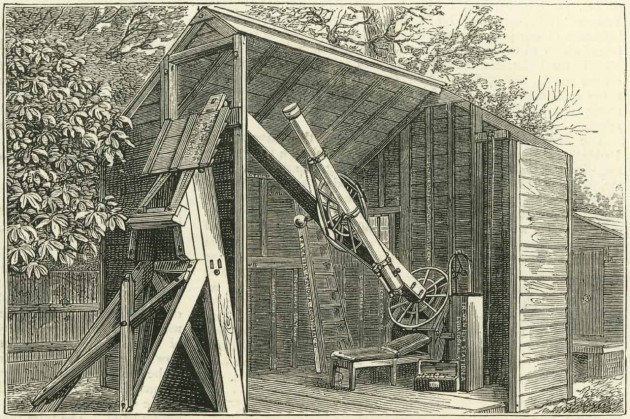
The Lee Equatorial undergoing testing at Greenwich prior to being shipped to Egypt for the 1874 Transit of Venus. The hut was set up roughly where the East Wing of the South Building stands today. The Depôt for Publications, which occupied the south-east corner of the Observatory site, is visible to its right. An original copy of the photograph from which the engraving was made is held in the archives at Cambridge (RGO6/276, Box 2, Image 10). From The Graphic, 27 June 1874
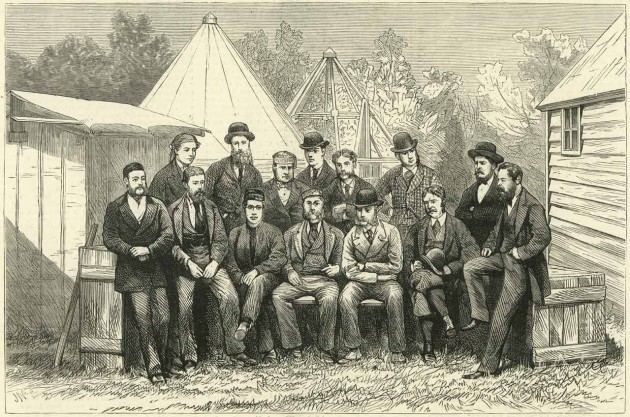
A composite image created from two photographs showing some of the members of the 1874 Transit of Venus expeditions superimposed onto an image of some of the Transit of Venus huts at the southern end of the South Ground at Greenwich. It was published in The Graphic on 27 June 1874. The engraver has depicted the huts correctly, but has altered the profile of the trees in the background and removed the Great Shed from behind the hut on the left. The original photograph (a copy of which can be found in the archives at Cambridge (RGO6/276, Box 1, Image 23) was taken looking in a roughly south-westerly direction and shows the path which still features in the image below running between the three huts on the left and the hut on the right. The group photo of the expedition members (a copy of which is held by the Royal Astronomical Society) was taken near the Magnetic Building against the fence that ran near its western edge. Identified members of the group include: E Walter Maunder (right); Captain (later Colonel) Tupman, who did much of the organising (front row, fourth from left); and Father Stephen Perry of Stonyhurst College (front row, third from left)
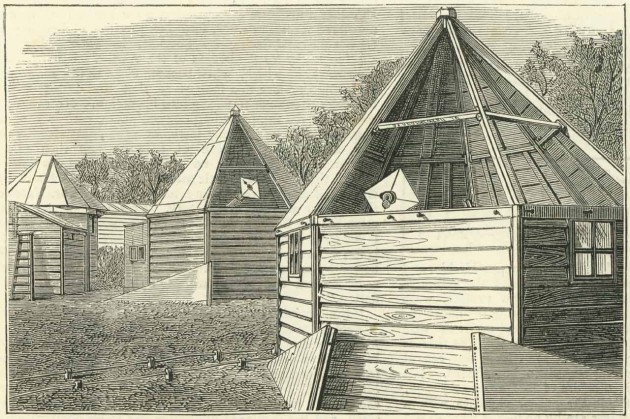
In this view, the permanent Kew Photoheliograph hut is on the left standing on brick foundations (which were completed on 18 November 1872 (RGO6/26)). To its right are huts for two of the Transit of Venus photoheliographs, the one on the right being destined for Station D (New Zealand). Each had a portable dark room attached. The viewpoint is from near the south-west corner of the Observatory site, looking across the South Ground towards the north-east. The low building behind the two huts on the left is the suite of seven Magnetic Offices, which when set up was close to the site's then boundary. The low level fencing running from the bottom left hand corner marks the edges of a path. An original copy of the photograph from which the engraving was made is held in the archives at Cambridge (RGO6/276, Box 1, Image 24). From The Graphic, 27 June 1874
After the Transit, many, but not all of the huts were returned to Greenwich. One transit hut (for examination of personal equations) and one altazimuth hut (for practice of the officers of the Arctic Expedition) were set up in the South Ground. Some of the other of the building-frames and stores were also stored there, others were placed in the temporary enclosure at the bottom of Greenwich Park and some where left overseas. The photographic hut of Station A was set up by permission of the Superintendent of the Royal Naval School, in the grounds of that school for a re-examination of photographic distortion using De La Rue’s scale. Four were subsequently lent for exhibition at South Kensington and one was at Chatham. By 1878, Airy reported to the Vistors that:
‘Of the portable huts used for the Transit of Venus: two Photoheliograph Huts are at the Cape of Good Hope and at South Kensington; and one Transit Hut, conveyed to Ascension for the use of Mr. Gill in observations of Mars for solar parallax, has been left there for the use of the Military Establishment. All others are either lodged in the Reserve Ground of Greenwich Park, or are abandoned or broken up.’
In 1885, a transit hut with a canvas roof was erected in the South Ground for the use of Commander Moore and Lieut. Douglas of the Royal Navy and then left in situ for occasional transit observations.
In June 1887, The Cooke 6-inch equatorial was mounted temporarily in the South Ground for observation of occasional phenomena, a portable transit hut, with canvas flap on its roof, being used to protect it from the weather.
In 1888, two transit huts were set up in the Courtyard for a series of observations to determine the Greenwich Paris Longitude difference. The results proved unsatisfactory so the process was repeated in 1892 and again in 1902. The English Observers hut was replaced by a brick Transit Pavilion in 1891 and the other hut removed following the 1902 re-determination.
On 26 April 1894, a photoheliograph hut and instrument was set up on the roof of the South wing of the South Building. It can be seen in the 1897 photograph of the Great Shed reproduced above. It appears to have been removed at the end of July 1898.
Following completion of the Lower Store in 1908, the surviving sheds appear either to have been broken up or put into storage.
Acknowledgements
Special thanks are due to the Greenwich Heritage Centre for permission to reproduce the 1897 photograph of the Great Shed and partially completed South Building.
© 2014 – 2026 Graham Dolan
Except where indicated, all text and images are the copyright of Graham Dolan